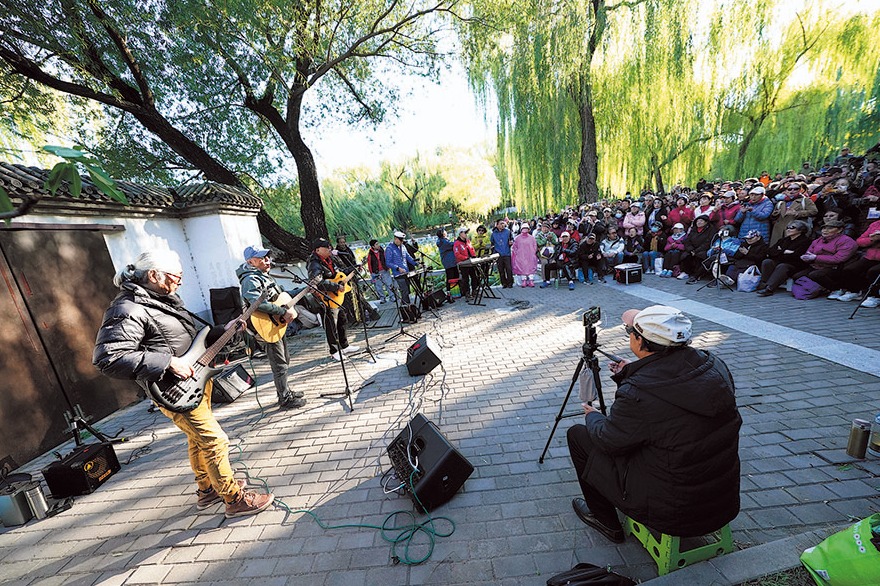Bridge for villagers in Xinjiang is a journey to convenience

URUMQI-Stepping on a pier, Parhati Aihimaiti clutched a beam in one hand for support and repaired the barbed wire that fastens guardrails on the left side of a bridge.
He then walked over the bridge several times, inspecting it for any repair work he could do to make it more secure and stable.
Measuring 17 meters in length and about 1 meter in width, the bridge, crossing Qagantokay River, is in the Qagantokay village of Yumin county, Northwest China's Xinjiang Uygur autonomous region.
As the initiator and one of the bridge builders, he is a former police officer with the Qagantokay border police station in charge of the Qagantokay village management from 2009 to 2020.
"At that time, I visited 80 households of herdsmen every week and was on call 24 hours a day to help with various kinds of requests. For instance, asking whether I could assist them in finding their lost sheep and cattle, resolving grassland disputes, or rescuing vehicles in distress," the 38-year-old recalls.
When he first came to the village in 2009, little did he know that he would develop such close relationships with the herders living here, let alone build them a bridge.
In May 2016, he and his wife rambled about in the village during their lunch break. They came across Kulumhan Byimhan, then a 53-year-old villager, holding her granddaughter and struggling to get to the passenger station to catch a bus.
If Kulumhan Byimhan could wade across the river on pebbles, her distance to the station would only be a few hundred meters. However, she could not walk through the river as she suffered from severe arthritis due to years of herding. She could only trek over mountains for about two hours with her granddaughter to get to her destination, with their clothes drenched in sweat.
"Why don't we try to build a bridge for them to facilitate their daily traveling?" Parhati Aihimaiti says his wife told him.
Building a bridge was no easy task for the couple, both financially and technically.
They had just saved more than 40,000 yuan ($6,176) and planned to buy a car so that Parhati Aihimaiti's wife could take their son from the county 25 kilometers away to the police station for reunions on weekends.
Also, they had no idea how to build such a structure.
After a silent night, the couple decided to make the bridge their top priority and give it a go.
With a total budget of 12,000 yuan, Parhati Aihimaiti invited his friend Eilen as the chief engineer and several police officers as helpers. Eilen was then a village cadre and a master of welding and carpentry.
They finally broke ground on the bridge-building project in mid-May with materials, including cement, iron, and wood demanded by Eilen and purchased by Parhati Aihimaiti's wife. They exerted every minute of their spare time to speed up the process.
For Parhati Aihimaiti, the time building the bridge swung between excitement and worries.
When Parhati Aihimaiti took 15 police officers and herdsmen to carry the 12-meter-long, 1 metric ton iron bridge to lay it on the river banks a month later, he found that the bridge was 5 meters short and could not reach the other side. They then lengthened the bridge by 5 meters and successfully laid it on the river banks.
Ten days later, a flood washed away the pier on one side of the bridge. After examining the scene, Parhati Aihimaiti found that the right bank pier stood on a soft-earthen dam. It was structurally unsound, and the distance between the bridge deck and the river surface was prone to flooding.
They racked their wits and later laid a 1.5-meter-deep foundation on the river banks, and then fixed the iron bridge firmly on the foundation by welding and pouring cement. It not only enhanced the pier's stability but also raised the distance between the bridge deck and the river surface.
More than two months of round-the-clock construction and fixing work followed. The bridge was finally ready for use in July 2016 and has benefited the villagers since then.
"The villagers see me not like their guest but as a family member. Every time I visit them, they always treat me with a cup of hot milk tea, doughnut-like Buarsak and candy," says Parhati Aihimaiti.
In the past year, he was transferred to another border police station to work. But the bridge still lingers in his mind.
When Parhati Aihimaiti left, he could not help worrying about the bridge. What if the barbed wire on the guardrail got loose? What if the villagers slip when they walk down the steep and slippery soil slope beside the bridge during winter seasons?
"The village will help solve these problems and identify security risks," says Ye Xianhua, village secretary of Qagantokay, adding that the village will undertake the bridge maintenance and reinforcement work and pave a stone staircase on the slope to facilitate the daily trips of the villagers.
"We will pass on the warmth brought by the bridge to the herdsmen," Ye says.
Xinhua




































